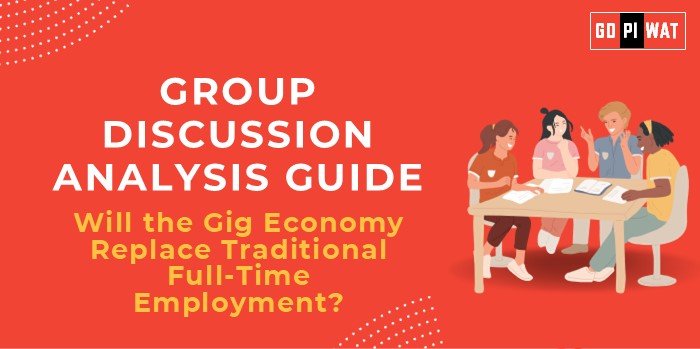📋 Will the Gig Economy Replace Traditional Full-Time Employment?
🌐 Introduction to the Topic
Opening Context: The gig economy has grown significantly with the rise of digital platforms, offering flexible and task-based work globally. This shift challenges traditional full-time employment and has far-reaching implications for the workforce.
Topic Background: The gig economy, characterized by short-term and freelance contracts, has expanded due to advancements in technology and changing work preferences. Platforms like Uber, Upwork, and Fiverr have led this transformation, while traditional employment models, offering job security and long-term stability, face scrutiny amid evolving work dynamics.
📊 Quick Facts and Key Statistics
- 🌍 Global Gig Workforce: Over 1.1 billion gig workers in 2023, fueled by increasing digital connectivity and task-based jobs.
- 🇮🇳 India’s Gig Workforce: Expected to reach 23.5 million by 2029-30, reflecting the country’s shift towards flexible work structures.
- 📈 Employment Growth Comparison: Gig work growth rates significantly outpace traditional employment growth globally.
- 😷 Impact of COVID-19: Pandemic-driven reliance on gig workers highlighted the need for workforce flexibility and adaptability.
- 💵 Economic Contribution in the U.S.: The gig economy contributes approximately $1.3 trillion annually to the U.S. economy.
🔗 Stakeholders and Their Roles
- 🏛️ Government and Policymakers: Develop regulatory frameworks to protect gig workers while promoting economic flexibility and competitiveness.
- 🏢 Employers/Corporations: Leverage gig workers for operational flexibility but face criticism for not providing standard benefits like healthcare.
- 👥 Workers/Employees: Gig workers benefit from flexible arrangements but often face job instability, lack of benefits, and irregular income.
- 💻 Digital Platforms: Companies like Uber, Upwork, and Fiverr facilitate gig work but face scrutiny over worker treatment.
- 🤝 Labor Unions and Advocacy Groups: Push for rights and protections for gig workers, seeking benefits akin to traditional employees.
✅ Achievements and 🚩 Challenges
✅ Achievements:
- ✨ Flexibility and Autonomy: Gig work allows individuals to tailor their schedules, enhancing work-life balance.
- 💼 Economic Opportunities: Provides income for diverse groups, including women and rural populations.
- 💻 Technological Enablement: Platforms lower entry barriers for workers to access global markets, democratizing work.
- 📉 Cost Efficiency for Companies: Businesses can adapt without long-term financial commitments of full-time employees.
🚩 Challenges:
- 📉 Lack of Job Security: Workers face unstable income streams and lack benefits like insurance or paid leave.
- ⚖️ Wage Disparities: Many gig workers earn less than minimum wage after expenses.
- 🌍 Regulation and Worker Rights: Ongoing debates on whether gig workers should be classified as employees or contractors.
- 🔒 Technological Dependence: Algorithmic bias and lack of transparency in platform management practices.
🌏 Global Comparisons and 📚 Case Studies
Global Comparisons:
- 🇪🇺 Europe: Strong gig worker protections, including minimum wage standards in countries like France.
- 🇺🇸 U.S.: High gig adoption but contentious debates over worker classification as employees or contractors.
Case Studies:
- 🚗 India’s Ola and Uber Drivers: Mixed experiences with earning potential and disputes over platform terms.
- 📜 California Proposition 22: Redefined gig worker status for ride-sharing companies, balancing flexibility and benefits.
💬 Structured Arguments for Discussion
- Supporting Stance: “The gig economy offers unmatched flexibility and better income opportunities for those who prefer autonomy and diverse work experiences.”
- Opposing Stance: “Gig work often lacks basic labor protections and security, making it an unsuitable replacement for stable full-time employment.”
- Balanced Perspective: “The gig economy’s growth provides critical options for many, but robust regulation is necessary to balance flexibility and security.”
💡 Effective Discussion Approaches
- 🧑💻 Opening Approaches:
- “With 1.1 billion gig workers worldwide, the economic role of gig work cannot be overlooked.”
- “In countries like France, gig work is heavily regulated, ensuring better worker rights compared to less-regulated markets like the U.S.”
- 🔄 Counter-Argument Handling:
- Present international best practices for worker protections.
- Offer solutions for combining flexible work with employee benefits.
📌 Strategic Analysis of Strengths and Weaknesses
🌟 Strengths:
- 💼 Diverse Income Opportunities: Accessibility for skilled and unskilled workers.
- 🌍 Workforce Mobility and Flexibility: Suits modern work-life preferences.
❌ Weaknesses:
- ⚖️ Absence of Benefits: No health insurance, retirement plans, or paid leave.
- 📉 Unpredictable Earnings: Variability in income due to competition and market demand.
🚀 Opportunities:
- 🔄 Regulated Hybrid Models: Combining gig flexibility with worker protections.
- 💻 Technological Solutions: Tools to enhance worker rights and earnings stability.
⚠️ Threats:
- ⚖️ Legal Disputes: Over worker classification and platform practices.
- 📜 Monopolistic Platform Control: Concentration of power among a few gig platforms.
📚 Connecting with B-School Applications
- 🛠️ Real-World Applications: Explore the gig economy’s impact on finance, HR policy-making, and digital transformation initiatives.
- 🎓 Sample Interview Questions:
- “How can gig work reshape the future of labor markets globally?”
- “What policies can bridge gaps between traditional employment and gig work?”
- 🔍 Insights for Students:
- Analyze the disruptive effects of gig platforms on various sectors like marketing, logistics, and operations management.
- Explore policy frameworks that balance worker protections with platform growth.


